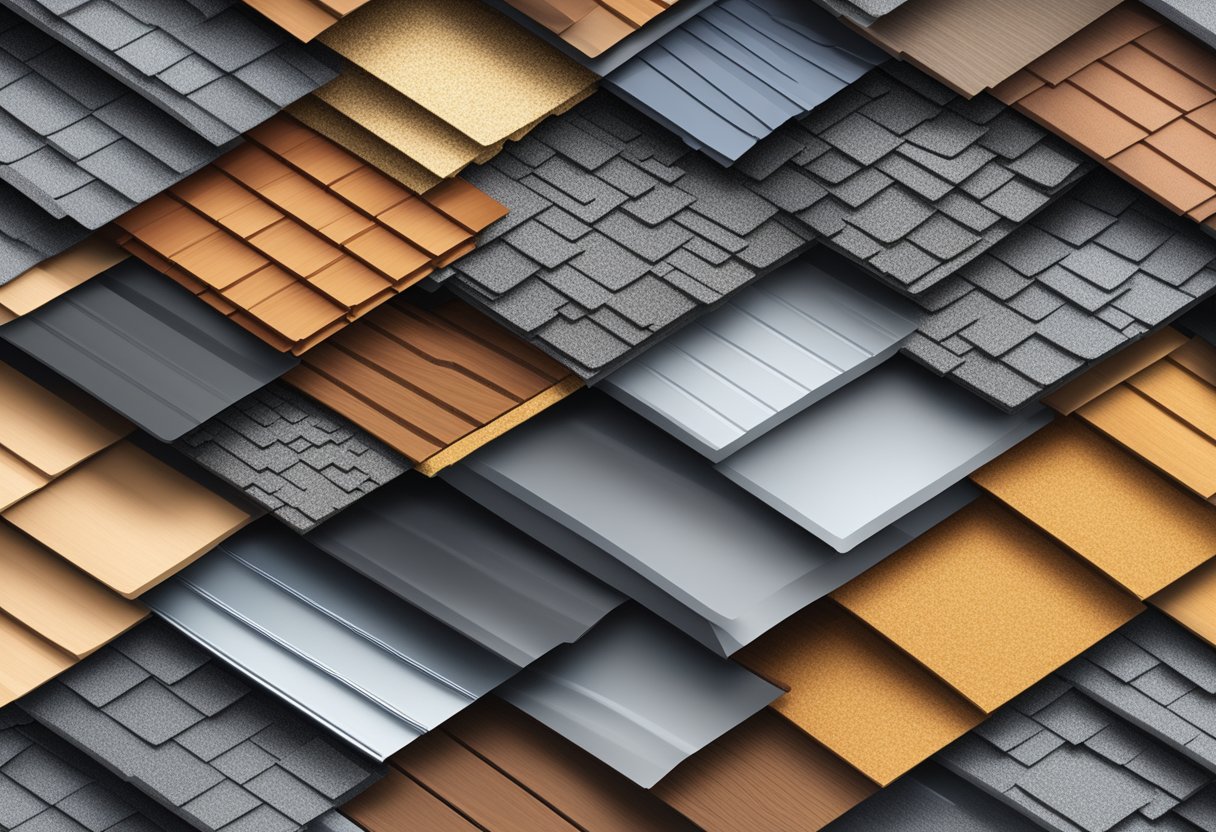Types Of Roof Shingles
Roof shingles are an essential part of any building’s roof, and there are various types of roof shingles available in the market. Each type of shingle has its unique characteristics, pros and cons, and costs that make it suitable for different roofing needs. Homeowners must consider several factors, including budget, climate, and style, before selecting the type of shingle for their roof.
The most common types of roof shingles include asphalt, metal, tile, wood, and slate shingles. Asphalt shingles are the most popular and affordable type of shingle, while metal shingles are more durable and can withstand harsh weather conditions. Tile shingles are known for their aesthetic appeal and are often used in Mediterranean-style homes. Wood shingles are eco-friendly and offer a natural look, while slate shingles are the most durable and long-lasting type of shingle.
When selecting the type of roof shingle, homeowners must also consider the design and style of their building. Different types of shingles offer various design options, including texture, color, and pattern. Additionally, the performance and durability of the shingles must be considered, as well as the installation and maintenance requirements. Finally, the cost analysis is an essential factor to consider, as different types of shingles have varying costs, including installation and maintenance costs.
Key Takeaways
- Homeowners must consider several factors, including budget, climate, and style, before selecting the type of shingle for their roof.
- Different types of shingles offer various design options, including texture, color, and pattern.
- Homeowners must also consider the performance and durability of the shingles, as well as the installation and maintenance requirements, before making a decision.
Types and Materials

When it comes to roofing, there are various types of shingles available in the market. Each type has its own set of advantages and disadvantages. In this section, we will explore the different types of shingles and materials used for roofing.
Asphalt Shingles
Asphalt shingles are the most popular type of shingles used in the United States. They are made of asphalt reinforced by fiberglass or organic materials like wood or cellulose. They come in multiple sizes and colors, making them a versatile option for any home. Asphalt shingles are also affordable and easy to install. They can last up to 20 years, depending on the quality of the shingle and the climate of the area.
Metal Shingles
Metal shingles are becoming increasingly popular due to their durability and energy efficiency. They are made of various metals such as aluminum, copper, and steel. Metal shingles can last up to 50 years or more and are resistant to fire, wind, and hail damage. They are also environmentally friendly, as they can be recycled at the end of their lifespan.
Wood and Cedar Shingles
Wood and cedar shingles are a traditional option for roofing. They are made of natural wood and are available in various shapes and sizes. They provide a rustic and natural look to the home. However, they are not as durable as other types of shingles and require regular maintenance to prevent rot, mold, and insect infestation.
Slate Shingles
Slate shingles are a premium option for roofing. They are made of natural slate stone and are available in various colors and sizes. They are durable and can last up to 100 years or more. However, they are expensive and require professional installation due to their weight.
Tile Shingles
Tile shingles are made of clay or concrete and are available in various shapes and colors. They are durable and can last up to 50 years or more. They are also fire-resistant and energy-efficient. However, they are heavy and require a strong roof structure to support their weight.
In conclusion, choosing the right type of shingles for your home depends on various factors such as the climate of the area, the style of the home, and the budget. It is important to consider all options and consult with a professional before making a decision.
Design and Style Considerations
When it comes to choosing the right type of roof shingles, design and style considerations play a significant role. The appearance of a roof can greatly impact the curb appeal of a home, and as such, homeowners should carefully consider the color, texture, and style of their shingles.
Color and Texture
Roof shingles come in a wide range of colors and textures, making it easy to find a style that complements the overall design of a home. Homeowners can choose from a variety of shades, including earthy browns, vibrant reds, and sleek grays. Texture options range from smooth and sleek to rough and rustic.
It’s important to consider the climate and location of a home when selecting the color and texture of shingles. For example, light-colored shingles are a popular choice in warmer climates as they reflect sunlight and help keep homes cool.
Architectural Shingles
Architectural shingles, also known as dimensional or laminate shingles, are a popular choice among homeowners due to their durability and aesthetic appeal. These shingles have a unique layered design that creates a three-dimensional look, adding depth and texture to a roof.
Architectural shingles come in a variety of styles, including slate, wood, and tile, making it easy to find a style that complements the overall design of a home.
Three-Tab Shingles
Three-tab shingles are a more traditional option that offers a classic look and a lower price point. These shingles are made of a single layer of material and are available in a variety of colors and textures.
While three-tab shingles may not have the same level of durability as architectural shingles, they are a budget-friendly option that can still provide adequate protection for a home.
Overall, when choosing the design and style of roof shingles, homeowners should consider their budget, climate, and personal preferences. With a wide range of options available, it’s easy to find a style that complements the overall design of a home while also providing the necessary protection and durability.
Performance and Durability
When it comes to choosing the right type of roof shingles, performance and durability are two of the most important factors to consider. Here are some things to keep in mind when making your decision.
Weather Resistance
Different types of roof shingles offer varying degrees of weather resistance. For example, asphalt shingles are a popular choice because they are relatively inexpensive and can withstand moderate weather conditions. However, if you live in an area with frequent severe weather, you may want to consider a more durable option such as metal or slate shingles.
Fire Rating and Safety
Another important consideration is the fire rating and safety of your roof shingles. Some types of shingles are more fire-resistant than others, which is especially important if you live in an area prone to wildfires. Look for shingles with a Class A fire rating, which indicates the highest level of fire resistance.
Insulation and Energy Efficiency
Insulation and energy efficiency are also important factors to consider when choosing roof shingles. Some types of shingles are designed to provide better insulation, which can help reduce your energy bills and keep your home more comfortable. Look for shingles with a higher R-value, which indicates better insulation.
In addition, some shingles are designed to be more energy-efficient by reflecting more sunlight and reducing heat absorption. This can help keep your home cooler in the summer and reduce your energy costs.
Overall, choosing the right type of roof shingles requires careful consideration of factors such as durability, weather resistance, fire rating, insulation, and energy efficiency. Be sure to do your research and choose a high-quality product with a strong warranty to ensure that your roof will last for many years to come.
Installation and Maintenance
Professional Installation
When it comes to installing roof shingles, hiring a professional contractor is highly recommended. A professional installation ensures that the shingles are properly installed, minimizing the risk of leaks and other issues that could arise from improper installation. Additionally, professional contractors have the necessary tools and experience to complete the job efficiently and effectively.
Before hiring a contractor, it’s important to do your research and ensure that they are licensed, insured, and reputable. You can check with your local licensing board to verify their credentials and read reviews from previous customers to gauge their level of expertise and customer service.
DIY Considerations
While it is possible to install roof shingles yourself, it is not recommended for those without experience in roofing or construction. DIY installations can lead to mistakes that could cause leaks and other issues, and may even void the shingle manufacturer’s warranty.
If you do decide to install shingles yourself, be sure to follow the manufacturer’s instructions carefully and take all necessary safety precautions. It’s also important to keep in mind that the installation process can be time-consuming and physically demanding, especially for larger roofs.
Long-Term Maintenance
Proper maintenance is key to ensuring the longevity of your roof shingles. Regular inspections can help identify any issues early on, preventing more serious problems from developing. It’s recommended to have your roof inspected by a professional once a year, and after any major weather events such as hail or high winds.
In addition to inspections, regular cleaning and debris removal can help prevent damage to your shingles. This includes removing any leaves, branches, or other debris that may accumulate on your roof. It’s also important to address any necessary repairs promptly to prevent further damage.
Overall, proper installation and maintenance are essential for ensuring the longevity and performance of your roof shingles. Whether you choose to hire a professional contractor or take on the installation yourself, it’s important to follow all manufacturer instructions and take necessary safety precautions. Regular maintenance and inspections can help identify and address any issues early on, preventing more serious problems down the line.
Cost Analysis
When it comes to choosing the right type of shingle for your roof, cost is often a major factor to consider. In this section, we will explore the different aspects of shingle cost, including budgeting, cost vs. value, and longevity and replacement.
Budgeting for Shingles
Budgeting for shingles can be a daunting task, but it is an important step in the roof replacement process. The cost of shingles can vary greatly depending on the type of material, quality, and size of the roof. It is important to keep in mind that while some shingles may be more affordable upfront, they may not last as long as more expensive options, leading to more frequent replacements and ultimately higher costs in the long run.
Cost vs. Value
When considering the cost of shingles, it is important to also consider the value they provide. While luxury shingles may come with a higher price tag, they often offer superior durability, lifespan, and curb appeal. Additionally, high-quality shingles can increase the value of your home, making them a worthwhile investment for homeowners.
Longevity and Replacement
The longevity of shingles is another important factor to consider when looking at cost. While some shingles may be more expensive upfront, they may last significantly longer than cheaper options, ultimately saving homeowners money in the long run. It is also important to keep in mind that shingles will eventually need to be replaced, and budgeting for this replacement is an important part of the cost analysis.
In summary, when it comes to shingle cost, it is important to consider both the upfront price and the long-term value they provide. By budgeting for shingles, considering cost vs. value, and factoring in longevity and replacement, homeowners can make an informed decision when choosing the right type of shingle for their roof.






